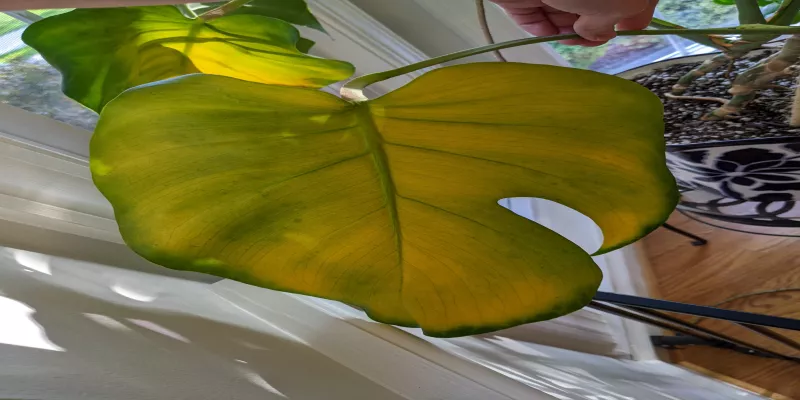Monstera Deliciosa Watering

Monstera Deliciosas are trendy houseplants. They earned that popularity from being a quick-growing and relatively easy-to-care-for houseplant. They sport large green leaves that develop holes that are called fenestration. It can take Monsteras some time to develop fenestration which can lead people to wonder whether they are watering properly. In reality, the maturity of the plant and the amount of sun have more to do with it. Regardless in this post, I’ll cover everything you need to know about Monstera Deliciosa watering.
How to Time Monstera Deliciosa Watering
There is no predefined frequency of watering that is best to follow. Watering frequency depends on too many factors like pot size, how many drainage holes your pot has, how much water you give each time, how many stems are in the pot, how much sun it receives, and your home’s relative humidity. And that isn't even an exhaustive list. If you keep your plant indoors and you’re watering it properly, you may be able to stick to a weekly schedule once you learn how much water to supply each time. You'll hear most plant growers say that you should aim to water deeply and less often rather than giving frequent small amounts.
The frequency and amount of water you give will also change throughout the year. During the growing season, you will need to water more frequently. You should start to decrease watering when your plant goes dormant. Generally speaking spring, summer, and early fall are considered the growing season and winter is dormant. When sunlight is in short supply, i.e. winter, your plant will go dormant. Please note that indoors "dormant" plants may still grow, but don’t expect it and it’s best not to encourage growth during that time either. Growth, when there isn't adequate light, will result in a leggy unhealthy plant.
Bottom Watering a Monstera Deliciosa
If your plant is small enough to move around, you may want to consider bottom watering your Monstera. Bottom watering is a technique where you fill a sink or tub with water up to a few inches and then place your plant pot directly into the vessel. Let the plant soak for about ten minutes to allow the roots and soil an opportunity to suck up the water from the drainage holes in the bottom of the pot. Personally, I find this option to be messy and not worth the effort, but a lot of my plants are on the large side, which could impact my position. For example, a lot of water will drain out when you lift your plant pot out of the water.
When to Water a Monstera Deliciosa
The most important thing to know about when to water is that you should wait until the soil has dried about two inches from the top before you provide your plant with more water. Some people use their fingers to test moisture by sticking them in the soil. I personally don’t like to get dirt under my fingernail if I don’t have to, so I use a simple soil moisture meter. In my experience, this tool gives you more information and helps you become better at judging how much water to give at each watering over time.
Monstera Deliciosa Watering Mistakes
If you have sought out this post you may be questioning whether you have made a watering mistake with your Monstera. You may have overwatered or underwatered your Monstera. If you’re not sure, read on to learn about the signs of each mistake.
Underwatered Monstera Deliciosa
An underwatered Monstera will give you some visual signs. This may help you diagnose underwatering. Monsteras have really long stems and big leaves so you may see some drooping if you've been underwatering. In some cases of underwatering the long stems may appear wrinkled if you inspect them closely. However, in my experience, the thing you'll see first is some yellowing. Yellowing may occur on the leaf tips from underwatering. In addition, the oldest leaves, the ones closest to the base of the plant may also turn yellow because they are the most susceptible to underwatering (see the picture below). Of course, I don't advise you to wait for these signs because they are evidence of stress. Instead, you should proactively check the soil moisture to make sure you aren’t underwatering. Refer back to the section When to Water a Monstera Deliciosa for more information on how to monitor soil moisture.
If you believe you have been underwatering, it's okay. You can turn it around by upping the frequency or amount of water that you’re supplying. A soil moisture meter is going to help you stay on top of things and be more informed about your watering habits.
Overwatered Monstera Deliciosa
An overwatered Monstera may have leaves that appear wilted, which can be confusing. Wilting can look like drooping and might make you think it needs more water, but it’s actually the opposite. The best I can do to explain the difference is drooping is like sagging and wilting is more floppy. I don't know if that helps. Leaves on overwatered Monsteras may also have brown spots or rings on the leaves.
If you are overwatering your Monstera, you may just be able to pull back on watering. However, if you have been overwatering for a long time, then you may be in a situation where the roots have rotted. Root rot is difficult to treat. To decipher if you have root rot, follow my post on Monsteras with root rot. If the roots are dark brown and mushy, then they're rotten.
Do you have any other Monstera Deliciosa watering questions? Ask in the Comments.
Add new comment